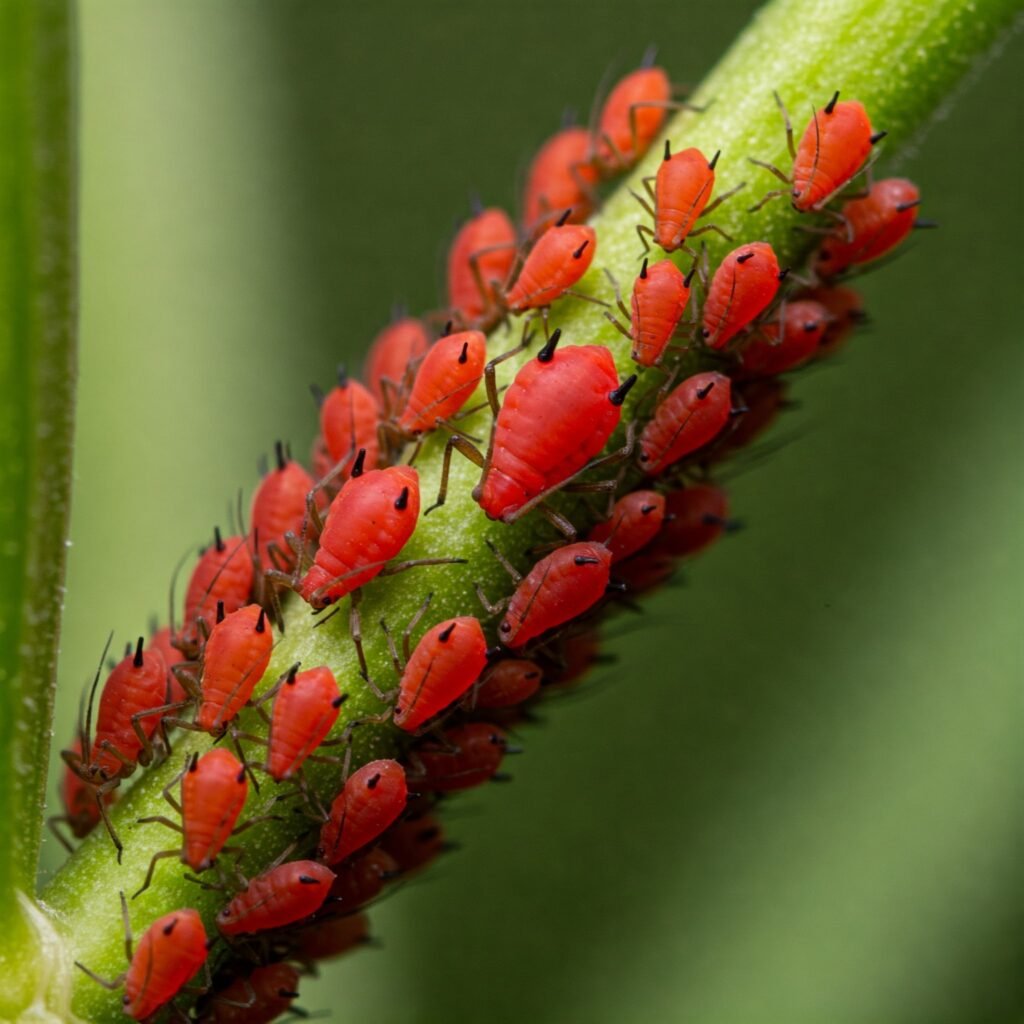Red aphids are among the most common and destructive garden pests. These tiny, sap-sucking insects can quickly overrun plants, causing stunted growth, deformed leaves, and even plant death. Their rapid reproduction makes them a persistent problem for gardeners and farmers alike.
In this comprehensive guide, we’ll dive deep into everything you need to know about red aphids—from identification and life cycle to organic and chemical control methods. By the end, you’ll have a complete action plan to protect your plants from these invasive pests.
What Are Red Aphids?
Red aphids (scientific name: Aphididae) are small, soft-bodied insects that feed on plant sap. They are typically bright red or reddish-brown and measure between 1-3 mm in length. Unlike some other aphid species, red aphids are particularly attracted to roses, vegetables (like tomatoes and peppers), and ornamental plants.
Why Are They a Problem?
- Rapid Reproduction: A single female can produce dozens of offspring in days.
- Honeydew Secretion: Their sticky waste attracts ants and promotes sooty mold.
- Disease Transmission: They spread plant viruses as they feed.
Early detection is key to preventing severe infestations.
How to Identify Red Aphids
Spotting red aphids early can save your plants from irreversible damage. Here’s what to look for:
Physical Characteristics
- Color: Bright red, sometimes with darker spots.
- Shape: Pear-shaped with long, thin legs and antennae.
- Size: Tiny (1-3 mm), often clustered on new growth.
Signs of Infestation
- Sticky Leaves: Honeydew residue on leaves and stems.
- Black Sooty Mold: Fungus that grows on honeydew.
- Curled or Yellowing Leaves: Damage from sap extraction.
- Ant Activity: Ants often “farm” aphids for honeydew.
If you see these signs, act quickly before the infestation spreads.
The Life Cycle of Red Aphids
Understanding their life cycle helps in timing control methods effectively.
1. Egg Stage (Overwintering)
- In colder climates, red aphids lay eggs on plant stems or bark.
- Eggs survive winter and hatch in early spring.
2. Nymph Stage
- Newly hatched nymphs begin feeding immediately.
- They molt several times before reaching adulthood.
3. Adult Stage
- Wingless adults reproduce asexually (cloning themselves).
- When overcrowded, some develop wings to spread to new plants.
4. Rapid Population Growth
- A single aphid can produce 80+ offspring in a week.
- Without intervention, infestations explode within days.
Damage Caused by Red Aphids
These pests harm plants in multiple ways:
1. Direct Feeding Damage
- Sap-sucking weakens plants, causing wilting and stunted growth.
- Heavy infestations can kill young plants.
2. Honeydew and Sooty Mold
- Honeydew attracts ants and fosters fungal growth.
- Sooty mold blocks sunlight, reducing photosynthesis.
3. Virus Transmission
- Red aphids spread plant viruses like cucumber mosaic virus.
- Infected plants may show mottled leaves or die prematurely.

15 Effective Ways to Control Red Aphids
1. Blast Them Off with Water
- A strong spray of water knocks aphids off plants.
- Best for light infestations (repeat every few days).
2. Introduce Natural Predators
- Ladybugs: Eat up to 50 aphids per day.
- Lacewings: Their larvae are voracious aphid hunters.
- Hoverflies: Adults pollinate, larvae eat aphids.
3. Apply Neem Oil
- Disrupts aphid hormones, preventing reproduction.
- Mix 2 tsp neem oil + 1 tsp dish soap in 1 quart of water.
4. Use Insecticidal Soap
- Kills aphids on contact without harming plants.
- Spray early morning or evening to avoid leaf burn.
5. Diatomaceous Earth (DE)
- Food-grade DE dehydrates aphids.
- Dust lightly on leaves (reapply after rain).
6. Companion Planting
- Repellent Plants: Garlic, chives, mint.
- Trap Crops: Nasturtiums lure aphids away from veggies.
7. Homemade Garlic or Pepper Spray
- Blend garlic + water, strain, and spray.
- Chili pepper sprays deter aphids naturally.
8. Prune Infested Leaves
- Remove heavily infested stems to stop spread.
- Dispose of clippings (do not compost).
9. Reflective Mulch
- Aluminum mulch repels aphids by confusing them.
- Works well for vegetable gardens.
10. Sticky Traps
- Yellow sticky traps catch winged aphids.
- Place near affected plants.
11. Beneficial Nematodes
- Microscopic worms that attack soil-dwelling aphids.
- Effective for root aphid species.
12. Essential Oil Sprays
- Peppermint, rosemary, or clove oil repel aphids.
- Dilute properly to avoid plant damage.
13. Row Covers
- Physical barrier prevents aphids from reaching plants.
- Ideal for seedlings and young crops.
14. Organic Pesticides (As Last Resort)
- Pyrethrin-based sprays (derived from chrysanthemums).
- Use sparingly to protect pollinators.
15. Chemical Insecticides (Final Option)
- Systemic insecticides (e.g., imidacloprid) for severe cases.
- Avoid overuse to prevent pesticide resistance.
Red Aphids Preventing Future Infestations
Prevention is always better than cure. Follow these best practices:
1. Regular Plant Inspections
- Check undersides of leaves weekly.
- Isolate new plants before introducing them.
2. Avoid Over-Fertilizing
- Excess nitrogen promotes tender growth, attracting aphids.
- Use slow-release organic fertilizers.
3. Encourage Biodiversity
- Plant flowers to attract predatory insects.
- Avoid monoculture planting.
4. Maintain Plant Health
- Healthy plants resist pests better.
- Water properly (avoid drought stress).
Frequently Asked Questions
Q: Can red aphids infest indoor plants?
Yes, they can hitchhike on new plants or through open windows.
Q: Do red aphids bite humans?
No, they only feed on plants.
Q: How do I get rid of aphid-attracting ants?
Use ant baits or sticky barriers around plant stems.
Red Aphids : Conclusion
Red aphids may seem small, but their impact on gardens and crops is enormous. By combining early detection, natural predators, and targeted treatments, you can keep infestations under control.
Start implementing these strategies today to enjoy a thriving, aphid-free garden. Have questions or success stories? Share them in the comments below!
